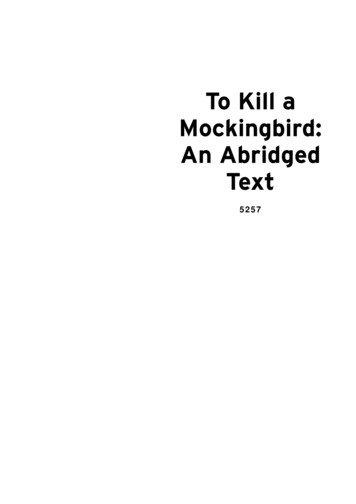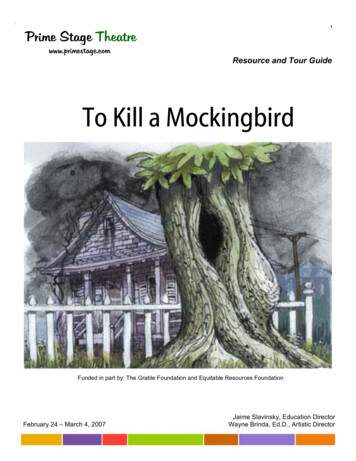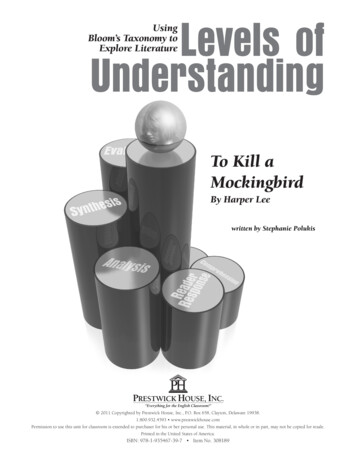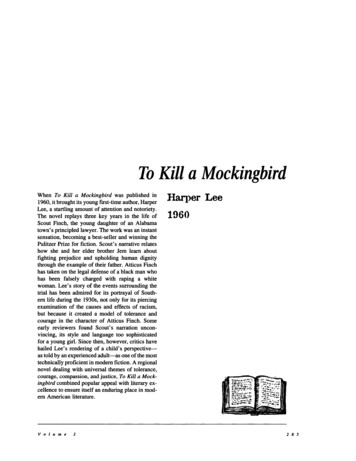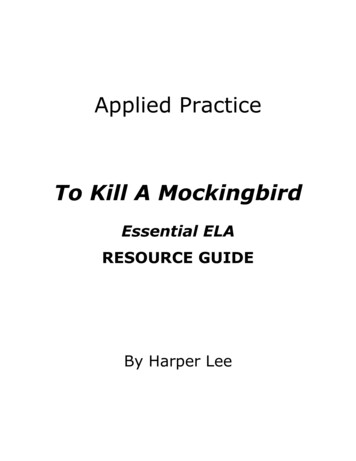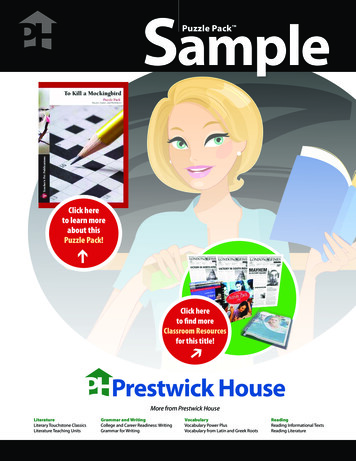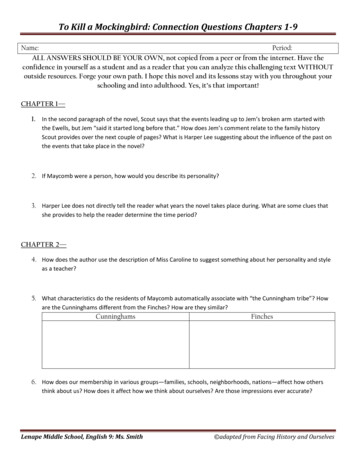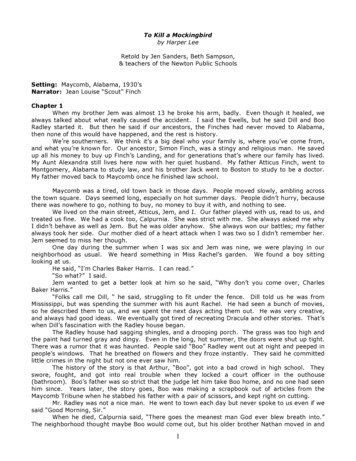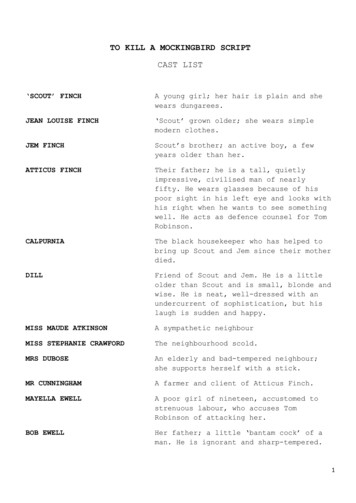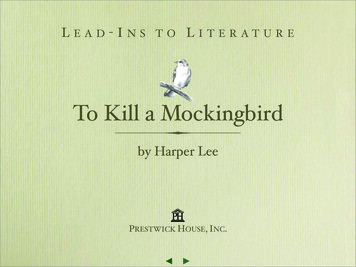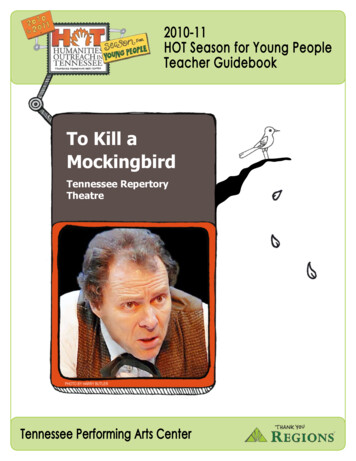
Transcription
2010-11HOT Season for Young PeopleTeacher GuidebookTo Kill aMockingbirdTennessee RepertoryTheatrephoto by harry butlerTennessee Performing Arts Center
TPAC Education is made possible inpart by the generous contributions,sponsorships, and in-kind gifts from thefollowing corporations, foundations,government agencies, and otherorganizations.AT&TAmerican AirlinesThe Atticus TrustBank of AmericaBaulch Family FoundationBMIBridgestone Americas Trust FundBrown-FormanCal IV EntertainmentCaterpillar Financial ServicesCorporationCentral Parking CorporationCoca-Cola Bottling Co.The Community Foundationof Middle TennesseeCorrections Corporationof AmericaThe Danner FoundationDavis-Kidd Booksellers Inc.The Dell FoundationDollar General CorporationDoubletree Hotel DowntownNashvilleFidelity Offset, Inc.First Tennessee BankSamuel M. Fleming FoundationPatricia C. & Thomas F. FristDesignated Fund*Gannett FoundationGaylord Entertainment FoundationThe Gibson FoundationLandis B. Gullett Charitable LeadAnnuity TrustGroupXcelHCA-Caring for the CommunityIngram Arts Support Fund*Ingram Charitable Fund, Inc.*Lipman Brothers, Inc.Mapco Express/Delek USMeharry Medical CollegeThe Memorial FoundationMetropolitan Nashville AirportAuthorityMiller & Martin, PLLCMorton’s,The Steakhouse,NashvilleNashville Predators FoundationNational Endowment for the ArtsNissan North America, Inc.NovaCopyPiedmont Natural Gas FoundationPinnacle Financial PartnersThe Premiere EventPublix Super Markets CharitiesMary C. Ragland FoundationThe Rechter Family Fund*Sheraton Nashville DowntownSouth ArtsHOT Transportationgrants underwritten byIrvin and Beverly Small FoundationSunTrust Bank, NashvilleEarl Swensson Associates, Inc.TargetThe TennesseanGreen Power Switch Universal Music Group NashvilleU.S. Trust, Bank of America PrivateWealth ManagementVanderbilt UniversityThe Wachovia Wells FargoFoundationWaller Lansden Dortch & DavisXMi Commercial Real Estate*A fund of the CommunityFoundation of Middle TennesseeSpecial Thanks to:The HCA Foundation on behalfof HCA and the TriStar Family of Hospitals2010 Hotel Sponsor for TPAC Education:Homewood Suites by Hilton - Nashville Downtown
Dear Teachers, Table of ContentsKey Points about the story .1From the Director- TennesseeRepertory Theatre . 2About the author and time period .3Researching the time period . .4Scottsboro Boys trials .5Excerpts from summations 6Lesson – Point of View. .7Lesson – Creating a Just World . .9Lesson – I Look at the World . 11More Ideas and Web Resources. 12Guidebook written and compiled by Cassie**Teacher Note: Please note that thelanguage from the book has not been edited.This performance will contain stronglanguage and racial epithet.LaFevor. Editing by Susan Sanders and KristinDare-Horsley.
Key Points aboutTo Kill a MockingbirdFull Title · To Kill a MockingbirdAuthor · Harper LeeGenre · Coming-of-age story; social drama; courtroom drama; Southern dramaDate of first publication · 1960Narrator · Scout narrates the story herself, looking back in retrospect an unspecifiednumber of years after the events of the novel take place.Point of View · Scout narrates in the first person, telling what she saw and heard at the timeand augmenting this narration with thoughts and assessments of her experiences inretrospect. Although she is by no means an omniscient narrator, she has maturedconsiderably over the intervening years and often implicitly and humorously comments on the naïveté she displayed in herthoughts and actions as a young girl. Scout mostly tells of her own thoughts but also devotes considerable time torecounting and analyzing Jem’s thoughts and actions.Tone · Childlike, nostalgic, innocent; as the novel progresses, increasingly dark, foreboding, and critical of societyTense · PastSetting · 1933–1935 in the fictional town of Maycomb, AlabamaMajor Conflict · The childhood innocence with which Scout and Jem begin the novel is threatened by numerous incidentsthat expose the evil side of human nature, most notably the guilty verdict in Tom Robinson’s trial and the vengefulness ofBob Ewell. As the novel progresses, Scout and Jem struggle to maintain faith in the human capacity for good in light ofthese recurring instances of human evil.Rising Action · Scout, Jem, and Dill become fascinated with their mysterious neighbor Boo Radley and have anescalating series of encounters with him. Meanwhile, Atticus is assigned to defend a black man, Tom Robinson againstthe supposed rape charges Bob Ewell has brought against him. Watching the trial, Scout, and especially Jem, cannotunderstand how a jury could possibly convict Tom Robinson based on the Ewells’ clearly fabricated story.Climax · Despite Atticus’s capable and impassioned defense, the jury finds Tom Robinson guilty. The verdict forces Scoutand Jem to confront the fact that the morals Atticus taught them cannot always be reconciled with the reality of the worldand the evils of human nature.Falling Action · When word spreads that Tom Robinson has been shot while trying to escape from prison, Jem strugglesto come to terms with the injustice of the trial and of Tom Robinson’s fate. After making a variety of threats against Atticusand others connected with the trial, Bob Ewell assaults Scout and Jem as they walk home one night, but Boo Radleysaves the children and fatally stabs Ewell. The sheriff, knowing that Boo, like Tom Robinson, would be misunderstood andlikely convicted in a trial, protects Boo by saying that Ewell tripped and fell on his own knife. After sitting and talking withScout briefly, Boo retreats into his house, and Scout never sees him again.SparkNotes Editors. “SparkNote on To Kill a Mockingbird.” SparkNotes.com. SparkNotes LLC. 2002. Web. 21 Jun. 2010.Stage Adaptation · Full-length play written by Christopher Sergel, published by The Dramatic Publishing Company. Thisstage version of Harper Lee’s beloved novel is described as the best sentiments of the novel in a two-hour story,capturing the humor and pathos of the book, while offering opportunities for theatricality in the performance.1
From the Director:Tennessee Repertory TheatreDear Teachers,Doing a stage adaptation of a work of literature is always a challenge, but when the source material is one of themost beautiful, influential novels of the last fifty years, the challenge is entirely daunting. One approaches TO KILLA MOCKINGBIRD with some hesitation if one loves the book with a passion, as I do. How is it possible foranything on the stage to do the book justice? The book is so rich, the imagery so complex and poetic, the narrativevoice so strong—how can that be distilled and formatted to the necessary shape of a play, which must be leanerand more direct?There are wonderful books that should no doubt never be made into a play—too much would not translate.Fortunately, TO KILL A MOCKINGBIRD is not one of those books, and the reason is simple. Harper Lee tells herstory like an old-fashioned storyteller—with vivid scene descriptions and brilliant dialogue spoken by whole andcompelling characters. This is the heart of theatre as well. Many conversations as well as the trial of TomRobinson almost in its entirety, can be lifted virtually unchanged from the book and placed on the stage. As Istarted to work on this project, I was delighted to learn that the “how” is made possible by the natural drama ofLee’s storytelling style. This is also evident when you watch the award-winning movie adaptation, with thescreenplay by one of America’s best playwrights, Horton Foote. In the screenplay, time is condensed andcharacters are consolidated or eliminated altogether. The plot focuses on the core of the book, intertwining the trialof Tom Robinson, the fascination with Boo Radley, and Atticus at the center. And it works beautifully. The stageadaptation takes its cue from the screenplay, particularly with regards to time, characters and trimming of plot.And, like the screenplay, the stage adaptation is rich with Lee’s dialogue from the book, dialogue which wasunerring in capturing the cadence of the speech of the time and place, and her wit sparkles throughout.Of course, another important question might be “Why bother?” -- Why bother to put Lee’s story on the stage if wecan’t have Aunt Alexandra or Uncle Jack, and we don’t get to watch Scout battle it out with her first teacher, or goto Finch’s Landing for Christmas, or visit Mrs. Dubose’s scary house with Jem to read to her? My answer is thatthe core of the story, the story about justice and human dignity and Atticus’ battle on their behalf, is one that theatreis uniquely suited to tell. Theatre, by its nature, teaches us to be human through its ability to inspire EMPATHY.The ability to feel empathy is what leads us to make ethical choices. An audience sitting together in a room,moved as one to feel empathy for Tom, is going to, as a group, come to feel the agony of such injustice. Thepower of Lee’s story as communicated by living actors is magnified and heightened as it reverberates through aliving audience, and as a community we feel together that Boo Radley is deserving of our respect even though he’sdifferent from us, or that Atticus is the kind of person we want to be. This is a worthy enhancement to theexperience of the book in my opinion, and while it in no way replaces the experience of reading the book, it canexcite a feeling of shared response to the core values of the book, and in that shared response we are led to makeethical choices as a community.If experiencing communal imagination and empathy in a theatre excites even one person to read TO KILL AMOCKINGBIRD with a relish they were not able to conjure on their own, then as a theatre artist I will feel that in ourown small unique way, we have served this magnificent book.Rene Copeland, Producing Artistic DirectorAbout the CompanySince 1985, Tennessee Repertory Theatre has been a critically acclaimed regional theatre, creating high qualityprofessional productions and by serving as a prime cultural, educational, and economic resource within the Nashvilleand Middle Tennessee communities. Tennessee Rep produces work that is designed, built, and rehearsed inNashville by highly skilled actors, designers, directors, and technicians. A non-profit organization, Tennessee Rep iscommitted to consistently delivering thought-provoking theatre each year.2
About the Author:Harper LeeNelle Harper Lee was born on April 28, 1926, to Amasa Coleman Lee and FrancesCunningham Finch Lee. Harper Lee grew up in the small southwestern Alabama townof Monroeville. Her father, a former newspaper editor and proprietor, was a lawyer whoalso served on the state legislature.Many details of To Kill a Mockingbird parallel Harper Lee’s own life. Like Lee, Scout isthe daughter of a respected small-town Alabama attorney, and Scout's friend Dill wasinspired by Lee's childhood friend and neighbor, Truman Capote. In 1931, Lee was thesame age when the first trials began in the small Alabama town of Scottsboro as Scoutat the start of Tom Robinson’s trial. During the Scottsboro trials, the nine defendantswere accused of raping two white women and were not provided with the services of a lawyer until the first day of trial.Despite medical testimony and no evidence, the all-white jury found the men guilty of the crime and sentenced all but theyoungest to death. The Scottsboro case left a deep impression on the young Lee, who would use it later as the roughbasis for the events in To Kill a Mockingbird.Lee completed To Kill a Mockingbird in the summer of 1959. Published July 11, 1960, it was an immediate bestseller andwon great critical acclaim, including the Pulitzer Prize for Fiction in 1961. It remains a bestseller with more than 30 millioncopies in print. In 1999, it was voted "Best Novel of the Century" in a poll by the Library Journal.Harper Lee on her book:“It is and it isn’t autobiographical. For instance, there is not an incident in it that is factual. The trial,and the rape charge that brings on the trial, are made up out of a composite of such cases andcharges What I did present as exactly as I could were the clime and tone, as I remember them, ofthe town in which I lived. From childhood on, I did sit in the courtroom watching my father arguecases and talk to juries.” -- New York Herald Tribune, 1962Image: Harper Lee in the courthouse ofMonroeville, Alabama. This courthouse wasthe setting for the movie version of her book.About the Time PeriodSet in a small Alabama town during the Great Depression, To Kill a Mockingbird is an example of historical fiction. Whenreading historical fiction, it's helpful to know about the real setting and time period.In her novel, Harper Lee strives to illustrate the racial climate of the South in the 1930s, a time when Jim Crow was thelaw of the land, racial segregation was deep-rooted, and mob rule unshakable.In To Kill a Mockingbird, Harper Lee makes many connections to real events of the time period that she was writing about.African American history during the Jim Crow era includes encounters with poverty, racism, disrespect, and protest. Leedevelops all four of these themes in her novel. The trial of Tom Robinson is directly related to the real life trials of the 9Scottsboro boys in the 1930s. Both of these trials focus around the same circumstances, the rape of a white woman byblack men. This novel is a study of American people and attitudes in the 1930's, and through Scout’s eyes, the readerencounters a world where people are judged by their race, and justice does not always prevail.3
Researching the Time Period:Create a Timeline and CollageTo prepare for reading this novel, it's helpful to know about the real setting and time period. Looking at theemotions and conflicts of the time provides a greater understanding of the story.Create a TimelineHistorical fiction is an ideal tool for learning about life in different eras. Literature transports students back in history,provides insight into the lives of people and events in time, and motivates students to want to learn more. Use a wall ofyour classroom to create a timeline of the era that includes the following elements:* important events in the novel and the years they occurred within the plot chronology* actual events for the same time period from researching the Depression and the 1930's(Helpful Hint: Look for historical references in the novel that can help you determine what year events occur. For example, in the firstchapter of To Kill a Mockingbird, Scout recalls that "Maycomb County had recently been told it had nothing to fear but fear itself," afamous phrase from Franklin D. Roosevelt's first Inaugural address in 1933. This historical reference tells readers that the novel beginssoon after FDR's 1933 Inauguration, which places the climax of the book around 1936. Use this reference as a starting place to figureout the plot chronology and to determine in which years the events in the novel take place.)After creating the timeline, discuss some of these questions:What did students learn about the era/history that they did not know before reading the book?What parallel from historical events and the novel surprised you?How do the real-life historical events affect the meaning of the story for you?Are you inspired to learn more about any of these events or people?Time Period Photo-Collage ActivityA collage is a collection of pictures which represents the creator'smental images on a theme or topic. In this activity, students willcreate a collage to depict the way they imagine, or visualize,scenes from To Kill a Mockingbird. Using the American Memorywebsite, students will select photos from federal archives as thepictures for a collage.The following web address will take you directly toimages of America from the Great Depression toWorld War II, 1935-1945, with pictures specificallyfrom Alabama - :@FILREQ(@field(SUBJ @band(Alabama--Childersburg )) @FIELD(COLLID fsa))Choose Depression-era photos from the state of Alabama, thesetting of To Kill a Mockingbird, then print out those which seem to illustrate parts of the novel to you.Instructions:1) Select 6 photographs which illustrate part of the setting of To Kill a Mockingbird.2) Create a caption to describe each photo.3) Select and include an excerpt or quote from the novel to explain the photos and captions.4) Compile your photos, captions, and quotations to construct a collage.5) Present your collage to a small group or to the class, explaining your choices.Example:Caption: Street scene of downtown MaycombQuote from the novel: "People moved slowly then. They ambled across the square,shuffled in and out of the stores around it, took their time about everything."4Image from the American Memory website, as noted above.
Scottsboro Boys TrialNo crime in American history produced as many trials, convictions,reversals, and retrials as the alleged gang rape of two white girls, VictoriaPrice and Ruby Bates, by nine black teenagers on a Southern Railroadon March 25, 1931.Trials of the “Scottsboro Boys” began only twelve days after their arrest.In just three days' time, eight of the nine boys, all under 21 - four of themunder 18 and two of them sixteen or under - were pushed through trialsand sentenced to death without even the chance to communicate withtheir parents.The cases were appealed to the United States Supreme Court whichoverturned the convictions in the landmark case of Powell vs. Alabama.The Court ruled that the right of the defendants under the FourteenthAmendment to competent legal counsel had been denied by Alabama.The boys would have to go through new trials.The second round of trials began with Haywood Patterson on March 30, 1933, in the courtroom of Judge James Horton.During this trial, one of the accusers, Ruby Bates, admitted to perjury. Under direct examination, Bates said a troubledconscience and the advice of a New York minister prompted her to return to Alabama and tell the truth about whathappened. Bates said that there was no rape, none of the defendants touched her or even spoke to her, and theaccusations of rape were made after Victoria Price told her "to frame up a story."At one o'clock on April 8, 1933, the jury was sent out to deliberate. The jury pronounced Haywood Patterson guilty andsentenced him to death. The decision on guilt took only five minutes. The testimony of Bates wasn't even considered.In 1976, over 40 years after being accused, the last Scottsboro defendant was finally pardoned.Image: “The Scottsboro Boys” meet with their attorney;From Douglas Linder’s Famous American Trials website.Compare History with FictionDiscuss the Scottsboro Trial with students. As a class, identify similarities between the historical Scottsboro trial and thefictional trial of Tom Robinson.Identify similarities and differences between the two trials - the charges, the accused, the defense, theprosecution, community response, and outcome.Describe the similarities or differences between the historical and fictional characters of To Kill a Mockingbird Haywood Patterson and Tom Robinson; Victoria Price/Ruby Bates and Mayella Ewell; Judge Horton and AtticusFinch.Consider: In what ways does a fictional account of courtroom drama differ from a more historical account?Ask students to read the excerpts from Judge Horton and Atticus Finch’s comments to the jury on the adjacent page andconsider the following questions:What do these comments reveal about race relations in the south in 1933?How does Judge Horton’s speech compare to Atticus’ summary? How does it differ?Based on your knowledge of an actual court case (The Scottsboro Trials), does Atticus Finch’s courageousdefense of Tom Robinson seem realistic or overly idealistic?After discussing these, ask students to consider how they would address the jury in Tom Robinson’s case. Studentsshould write a speech addressing the jury to present to the class.5
Excerpts from Judge Horton’s Instructions to the Jury onApril 8, 1933Excerpts from Atticus Finch’s comments to the jury inTo Kill A Mockingbird, a full-length play based upon thenovel by Harper LeeShe admitted on the witness stand in this trial that shehad perjured herself in the other case. In considering theevidence, you may consider not only her lack of virtue asadmitted by her here, but also that she contradicted herprevious testimony as perjured.Gentlemen, this case is not a difficult one, it requires nominute sifting of complicated facts. This case is as simpleas black and white. The State has not produced one iotaof evidence that the crime Tom Robinson is charged withever took place. It has relied instead upon the testimonyof two witnesses – witnesses whose testimony has notonly been called into serious question on crossexamination, but has been flatly contradicted by thedefendant If in your minds the conviction of this defendant dependson the testimony of Victoria Price and you are convincedshe has not sworn truly about any material point, youcount not convict this defendant Take the evidence, sift it out and find the truths anduntruths and render your verdict. It will not be easy tokeep your minds solely on the evidence. Much prejudicehas crept into it. It has come not only from far away, butfrom here at home as well.I have done what I thought to be right as the judge ofthis court no matter what the personal cost to me mightbe There have been some statement in regard to whetheror not some other person thinks this way or that, orwhether or not public opinion is one way or the other.Gentlemen, that hasn’t anything to do with it – whatoutside opinion or public opinion is, or whether or not heideas of somebody else may be one way or the other.No, gentlemen, we are not to consider that at any time.I know the juries of this county. I have been with them –have been before them. They are sensible, reasonable,intelligent men. They do not go off on side issues, nor dothey let petty prejudices enter into the trial of the case.You are not trying whether or not the defendant is whiteor black – you are not trying that question; you are tryingwhether or not this defendant forcibly ravished awoman So a quiet, respectable Negro man had to put his wordagainst his two white accusers. I need not remind you oftheir conduct here in court – their cynical confidencethat you gentlemen would go along with them on theassumption – the evil assumption – that all Negroes lie,that all Negroes are basically immoral the truth is, someNegroes lie, and some Negro men are not to be trustedaround women – black or white. And so with somewhite men. This is a truth that applies to the entirehuman race, and to no particular race.In this year of grace, 1935, we’re beginning to hear morereferences to Thomas Jefferson’s phrase about all menbeing created equal. But we know that all men are notcreated equal – in the sense that some men are smarterthan others, some have more opportunity becausethey’re born with it, some men make more money, someladies make better cakes, some people are born giftedbeyond the normal scope - But there’s one way in whichall men are created equal. There’s one humaninstitution that makes the pauper the equal of aRockefeller, the stupid man the equal to an Einstein.That institution, gentlemen, is a court of law. In ourcourts – all men are created equal.But a court is only as sound as its jury, and a jury is onlyas sound as the men who make it up. I’m confident thatyou gentlemen will review without passion the evidenceyou’ve heard, come to a decision, and restore thisdefendant to his family.You are here at home as jurors, a jury of your citizensunder oath sitting in the jury box taking the evidence andconsidering it, leaving out any outside influences.Judge Horton’s speech text excerpted from Douglas Linder’s Trials/scottsboro/SB tri33tml.htmlAtticus Finch’s speech text from the play adaptation by Christopher Sergel.6
Understanding Perspectives:Point of ViewMany students read without questioning a text or analyzing the author's viewpoint. This lesson encouragesstudents to question what they are reading by looking at the author's purpose and examining multipleviewpoints.Grade Level: 7-12Standards addressed: English Standards 2, 3, and 8 – Communication, Writing, and LiteratureTheatre Standards 1.0 and 2.0 – Script Writing and Character ActingObjectives:The student will examine the importance of point of view.The student will analyze a character from To Kill a Mockingbird.The student will apply character analysis to compose journal entries as the character.Materials needed: images from the adjacent page (or other images of your choice that show point of view), copies of ToKill a Mockingbird, post-it notes, index cards with character namesInstructional procedures:Set – Show students the images from the adjacent page, one at a time and answer the following questions about each:Whose point of view is each image focused on? What story does each one tell you? How and why does the meaning ofthe photo change? What are the strengths of each? Does either story tell the full truth with no bias? Why?Stories are not reflections of reality but are selective versions of it, told from a particular view. The authorpositions the reader to respond to a story in particular ways through the use of language, point of view, etc.Towards the beginning of the story, Atticus tells Scout and Jem, “You never really understand a person until youconsider things from his point of view . . . until you climb into his skin and walk around in it.” What does Atticusmean by this?Scout narrates To Kill a Mockingbird in first person, looking back in retrospect an unspecified number of yearsafter the events take place. How does Scout’s point of view affect the narration of the story? Does her age makea difference? What are the strengths of the narration being her point of view? What impact does Scout’sperspective have on the novel? What information does her point of view omit or distort?Give each student an index card with a character name on it and several post-it notes. (Characters should includemain characters, but also descriptions of minor characters, such as a member of the black community sitting inthe balcony, a member of the jury who believed that Tom was innocent but was afraid to go against the otherjurors, a newspaper reporter from New York covering the trial, Reverend Sykes, Miss Maudie, etc. Some studentsmay have the same character name).Students should search through the book and place at least 5 post-its on pages that highlight different aspects oftheir character. On the post-it, they should note the page number and write a sentence that explains what thepassage teaches about the character.On a separate sheet of paper, students should answer the following questionsabout their character: What 3 adjectives best describe the character’s personality traits?What 2 questions would you like to ask this character that would help youunderstand the individual?What 2 objects or symbols do you associate with this character?How does this character feel about the Tom Robinson trial and the outcome?How does this character’s point of view differ from the narrator?Would this character be a reliable narrator?When students have finished answering the question, have students turn to someone near them and share abouttheir character.7
Next, students will write 2 journal entries from the character’s point of view. One should come from any part ofthe novel before the trial and one should be written immediately after the trial verdict. Ask them to accurately andappropriately represent the character in a voice that seems authentic to that individual as well as reveal somepreviously unknown fact from the character’s life.Closure - Use the journal entries as dramatic monologues to present to the class. Depending on time, you may wish tohave students volunteer, choose only one of their journal entries, or perform both in a separate class period.Assessment: Students should stick their post-it notes to the paper with their character answers to turn in with their journalentries.Extensions:As a social studies extension, discuss how history is usually told from a particular viewpoint, and even historybooks change or tell one side of a story. (Have students read 1984? Does our government change history?)Research historical events using sources from other countries. How does their version differ from ours?Debate - Select volunteers to debate one version of a story from different character viewpoints. Use a story all arefamiliar with, such as a fairy tale.Mock trial – Have students volunteer for different roles (e.g., judge, jury, lawyers, defendants, plaintiffs). Moststudents are familiar with courtroom proceedings from television programs, but some guidelines should bedeveloped ahead of time. For example, lawyers are limited to "time on the floor" to present their arguments andthe judge and jury make the final ruling. Give them a simple topic to start with, and progress to more controversi
To Kill a Mockingbird Full Title · To Kill a Mockingbird Author · Harper Lee Genre · Coming-of-age story; social drama; courtroom drama; Southern drama Date of first publication · 1960 Narrator · Scout narrates the story herself, looking back in retrospect an unspecified number of years after the events of the novel take place. Point of View · Scout narrates in the first person, telling .

